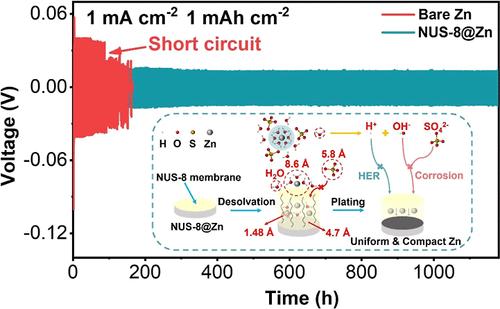A Binder-Free Metal–Organic Framework Ion Osmosis Membrane for Stabilizing a Zn Anode
IF 8.2
2区 材料科学
Q1 MATERIALS SCIENCE, MULTIDISCIPLINARY
引用次数: 0
Abstract
Aqueous zinc-ion batteries (AZIBs) have attracted considerable attention due to their low cost and high safety. However, their development is hindered by dendrite formation and complex anodic side reactions. In this study, a binder-free zirconium-based metal–organic framework (MOF) membrane, NUS-8, is proposed as an artificial solid electrolyte interphase (ASEI) for the Zn anode, with the aim to regulate Zn2+ desolvation and deposition processes, inhibit dendrite growth, and mitigate anodic side reactions. The microporous structure and abundant functional groups (–COOH, –OH) in the NUS-8 membrane enable ion flux control through an ion-confinement effect, reducing ion transfer resistance and providing stable pathways for Zn2+ migration. These characteristics enhance the hydrophilicity of the Zn anode surface, accelerate the desolvation process, and lower the activation energy barrier for Zn2+ migration from 28.73 to 26.10 kJ mol–1. As a result, symmetric cells with NUS-8@Zn anodes exhibited a prolonged lifespan exceeding 1180 h at 1 mA cm–2 and 1 mAh cm–2, significantly outperforming bare Zn anodes (90 h). Additionally, the NUS-8@Zn||MnO2 full cell demonstrated excellent cycling stability, with a capacity retention of 72.3% over 3000 cycles at 5 A g–1. This work presents a promising strategy to enhance Zn anode performance and introduces a design approach for advancing AZIBs.

稳定锌阳极的无粘结剂金属-有机框架离子渗透膜
水性锌离子电池(AZIBs)因其低成本和高安全性而受到广泛关注。然而,它们的发展受到枝晶形成和复杂的阳极副反应的阻碍。在这项研究中,提出了一种无粘结剂的锆基金属有机框架(MOF)膜NUS-8作为锌阳极的人工固体电解质界面(ASEI),旨在调节Zn2+的脱溶和沉积过程,抑制枝晶生长,减轻阳极副反应。NUS-8膜的微孔结构和丰富的官能团(-COOH, -OH)可以通过离子约束效应控制离子通量,降低离子转移阻力,为Zn2+迁移提供稳定的途径。这些特性增强了Zn阳极表面的亲水性,加速了脱溶过程,降低了Zn2+迁移的活化能垒,从28.73 kJ mol-1降低到26.10 kJ mol-1。结果,具有NUS-8@Zn阳极的对称电池在1ma cm-2和1mah cm-2下的寿命超过1180小时,显著优于裸锌阳极(90小时)。此外,NUS-8@Zn||MnO2全电池表现出优异的循环稳定性,在5 a g-1下循环3000次,容量保持率为72.3%。这项工作提出了一种有前途的策略来提高锌阳极的性能,并介绍了一种改进azib的设计方法。
本文章由计算机程序翻译,如有差异,请以英文原文为准。
求助全文
约1分钟内获得全文
求助全文
来源期刊

ACS Applied Materials & Interfaces
工程技术-材料科学:综合
CiteScore
16.00
自引率
6.30%
发文量
4978
审稿时长
1.8 months
期刊介绍:
ACS Applied Materials & Interfaces is a leading interdisciplinary journal that brings together chemists, engineers, physicists, and biologists to explore the development and utilization of newly-discovered materials and interfacial processes for specific applications. Our journal has experienced remarkable growth since its establishment in 2009, both in terms of the number of articles published and the impact of the research showcased. We are proud to foster a truly global community, with the majority of published articles originating from outside the United States, reflecting the rapid growth of applied research worldwide.
 求助内容:
求助内容: 应助结果提醒方式:
应助结果提醒方式:


